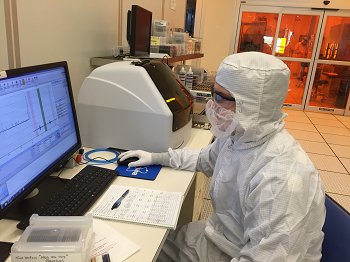
Alex Galli monitors a profilometer using quality control software he implemented and configured during his internship at the CNST.
A year ago, Alex Galli graduated from the University of Kansas with an interest in nanotechnology but no experience in the field. Now he's employed in a nanotech clean room at one of the foremost aerospace firms in the nation.
Critical to getting that job, Galli says, was a 4-month internship that he recently completed at the CNST. Co-sponsored by the Northeast Education and Technology Education Center (NEATEC) (http://neatec.org/), the internship gave Galli, now 23, hands-on experience with electron microscopes, vapor deposition tools and other nanotech instruments. (Galli's internship followed a summer workshop on nanotechnology at Penn State.) At the NanoFab, Galli applied the computer skills he acquired as a physics major at the U of Kansas to implement and configure new quality control software.
The software, based on a technique known as Statistical Process Control, is critical for quickly determining whether a NanoFab machine or process is meeting operating standards. For instance, the software revealed that something had gone awry in an electron beam vapor deposition process. In that operation, an electron beam heats and vaporizes a solid metal target in order to lay down a metal film of a specified thickness. Although the process should be repeatable thousands of times with virtually identical results, the software indicated that it had begun producing films about 20 nanometers thinner than desired.
Galli helped trace the problem to a cracked crucible holding the heated metal. The crack prevented the crucible from cooling properly, resulting in an anomalously thin layer.
It took time, he says, to understand the idiosyncrasies of the software and figure out the best format in which to input data collected from the NanoFab instruments. But by the end of Galli's internship, the software was monitoring some 100 processes on some 30 instruments in the NanoFab. Weekly to monthly, he also operated and recorded data from some of the instruments.
One of the best parts of the internship, he says, was simply "being part of NIST," Galli says. "There was so much going on all the time; there would be a seminar every week or so. I loved attending those because the research is so exciting."
By this fall, nine students will have completed the CNST-NEATEC internship program, which began in 2014. An intern from 2015, Paul Barrett, was hired by the CNST as a part-time lab assistant just after he finished the program.
"For someone who is still in school and just wants nanofabrication experience, or a recent graduate who's interested in the field but who may not have been exposed to it during their undergrad, it's a great opportunity," says Galli.
Always looking toward the future, Galli had applied for a job at Northrup Grumman even before he began his CNST internship. The interview took place while he was at the NanoFab. His work experience there "definitely set me apart from everyone else," Galli says. He finished the internship on Friday, April 29, and joined the company, at its Linthicum, Md., location, the following Monday.

